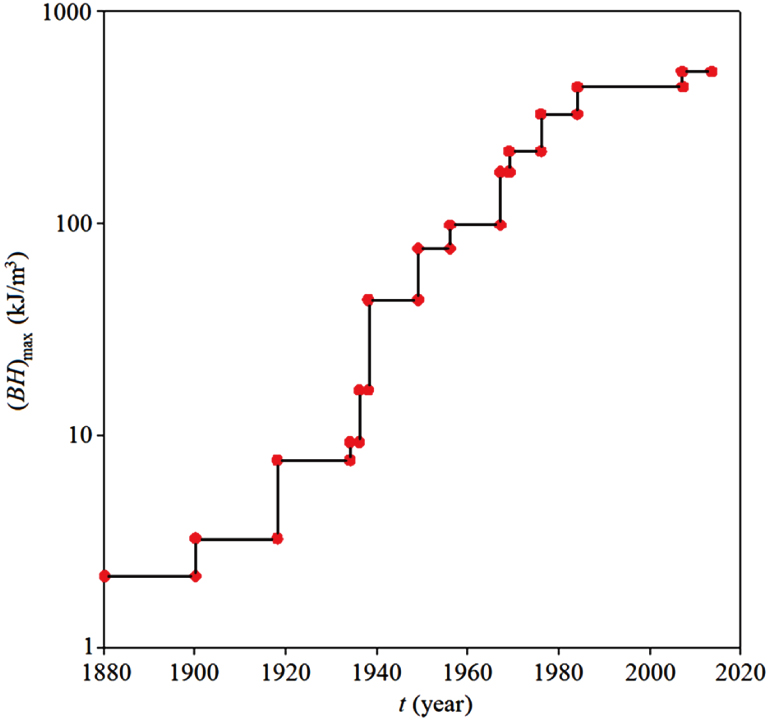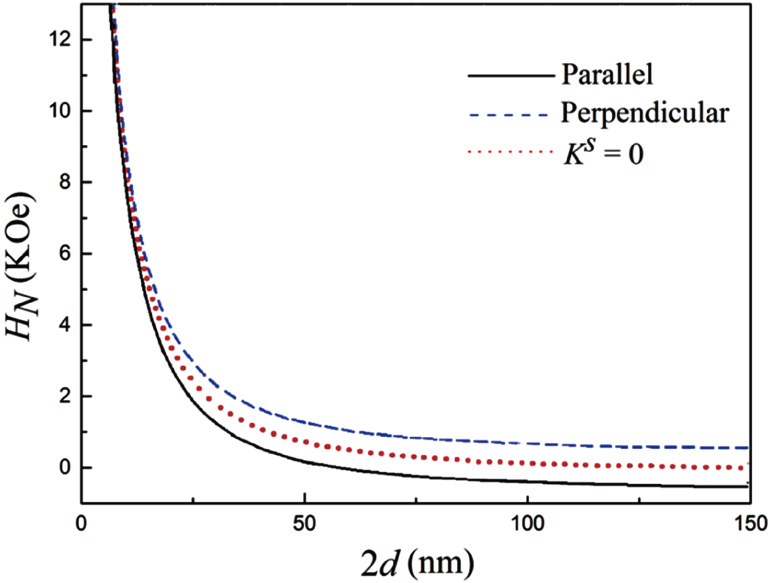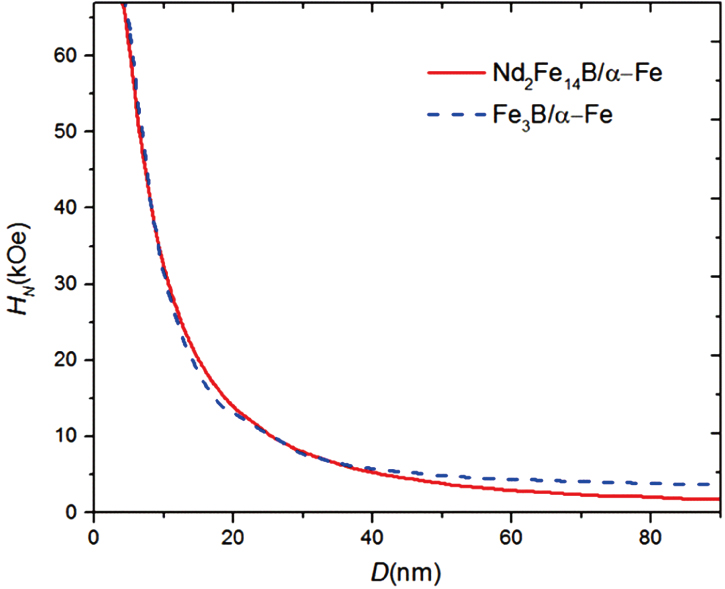† Corresponding author. E-mail:
Project supported by the National Natural Science Foundation of China (Grant Nos. 11074179, 51771127, 51571126, and 51772004) and the Scientific Research Fund of Sichuan Provincial Education Department, China (Grant Nos. 18TD0010 and 16CZ0006).
Coercivity mechanism in permanent magnets has been debated for many years. In this paper, various models of the coercivity mechanism are classified and re-examined by the comparison and contrast. Coherent rotation and curling models can reveal the underlying reversal mechanism clearly based on isolated grains with elliptic shapes. By contrast, the numerical methods consider inter-grain interactions while simulating the evolution of the spins and hysteresis loops with complicated shapes. However, an exact simulation of magnetic reversal in permanent nanomagnets requires many meshes to mimic the thin domain wall well.
Nucleation and pinning are the two main coercivity mechanisms in permanent magnets. The former signifies the beginning of the magnetic reversal, whilst the latter completes it. Recently, it is proposed that the large difference between the intrinsic magnetic properties of the nucleation centers and those of the main phase can result in a large pinning field (self-pinning), which has the attributes of both traditional nucleation and pinning. Such a pinning explains the experimental data of permanent magnets very well, including the enhancement of the coercivity by the grain boundary pinning.
Permanent magnets, which are available abundantly in modern life,[1–6] play an indispensable role as components of a wide variety of electromechanical and electronic devices. Roughly, an average home contains more than 100 permanent magnets and a car uses 12 on average. These magnets are being investigated, improved, and applied increasingly everyday, thus leading to a rapid change in our lives. In history, permanent magnetic materials marked the beginning of the magnetism.[3] The first use of the permanent magnets can be traced back to more than 2000 years ago in ancient China, where the prototype of the compass was invented and later used in navigation.
Permanent magnetic materials are characterized by their large coercivity and associated energy products, which could be millions times larger in comparison with soft magnetic materials. The application of the permanent magnets ranges from electric motors and generators, magnetic storage media, loudspeakers, door latches, and toys to ore separators, water filters, electric watches, and micro-tubes. These applications are related closely to the large coercivity, which can sustain for a long time. Therefore, coercivity mechanism is one of the key issues of permanent magnetic materials, and has not been completely understood yet. Generally, it is believed that the high coercivity is due to the high crystalline anisotropy K and hence the high anisotropy field Ha, as shown in Table
| Table 1.
Magnetic properties of various hard magnetic materials at room temperature, where Ms, K, and A denote spontaneous magnetization, anisotropy constant, and exchange constant, respectively |
In principle, the coercivity of the permanent magnet can be the same as its crystalline anisotropy field. However, the coercivity of most magnets is much smaller than the corresponding anisotropy field, leading to a paradox called as coercivity paradox.[17–19] Such a paradox was proposed by Brown in 1940s, which holds good for all kinds of permanent magnets, including the soft magnetic materials where the shape anisotropy field is dominant. The coercivity paradox is caused largely by the uncertainty of the coercivity mechanism in magnetic materials, especially in permanent magnets where the coercivity mechanism has been disputed for a long time.
Coherent rotation and curling are the main coercivity mechanisms of ideal materials, which are perfect in both phase composition and geometrical shape.[20–24] For these mechanisms to hold, the material must be an elliptical single-phased isolated grain without any defects, which can rarely be satisfied in real. Therefore, in general cases, nucleation and pinning are considered as the two dominant coercivity mechanisms, and the permanent magnets are classified accordingly into so-called nucleation-type and pinning-type materials. NdFeB is believed to be a nucleation-type material whereas SmCo a pinning-type material. However, some experimental results support the contrary conclusions.
Recently, it has been proposed that the real coercivity mechanism depends not only on the intrinsic magnetic properties of the material, but also on the microstructures such as defects and grain sizes.[10,25–27] Nucleation and pinning signify the beginning and end of the magnetic reversal respectively, and have to be analyzed as a whole. Therefore, the real coercivity mechanism could be a combined mechanism, which has the attributes of both traditional nucleation and pinning. Analyses show that interface pinning and grain boundary pinning are the dominant coercivity mechanisms of anisotropic and isotropic permanent nanomagnets, respectively. These two types of pinning are called as self-pinning, which occurs near the nucleation centers.
The review is arranged as follows: In Section
Permanent magnets are characterized by a high resistance to demagnetization, i.e., a large coercivity. The coercivity of the permanent magnetic materials, typically the rare earth iron or rare earth cobalt magnetic materials, can be as high as 10 MA/m,[1–3,28] which is six orders of magnitude larger than that of the soft magnetic materials. In addition, a typical permanent magnetic material should have a large remanence to have a high maximum energy product (BH)max. This product describes the ability of a permanent magnet to withstand the influence of an external magnetic field. Moreover, the energy product is a measure of the useful magnetic flux that can be produced by the magnet in a given volume.[1–3] Figure 


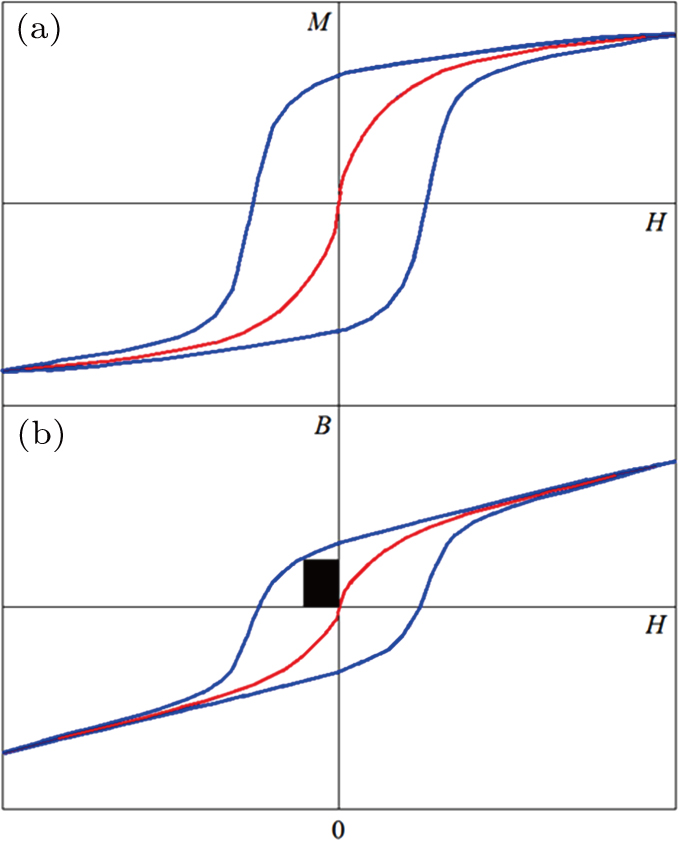 | Fig. 1. Hysteresis loop of a permanent magnet. The top shows the M–H hysteresis loop and the bottom the B–H hysteresis loop. The shaded area represents the maximum energy product of the material. |
In the history of the permanent magnetism, the relationship between the development of the magnetism and magnetic materials are reciprocal.[1–3,28] On the one hand, the advance in the magnetic materials progresses the theory of magnetism. On the other hand, the progress in magnetism accelerates the development of magnetic materials. As shown in Fig.
The mechanism of coercivity is an enduring topic of magnetism,[17,29–43] which is especially true because a permanent magnet characterized by a high coercivity is considered. The Stoner–Wohlfarth model (SW model)[44] is the most promising time-independent model to date. This model, based on the coherent rotation of the magnetic moments of single-domain grains with respect to their easy axes, gives the coercivity as 


While the remanence determined by the SW model is in reasonable agreement with the experimental value, the coercivity of both experimental and technical magnets, however, is at most 20%–40% of that determined by the SW model. This discrepancy is generally attributed to the crystal defects and inter-grain interactions, which are ignored in the SW model. Despite these disadvantages, the SW model, proposed in 1948, is still widely used in magnetism. One reason is that it is a very simple analytical model, and can provide an appropriate coercivity mechanism. The other reason is that although the measured coercivity Hc is much smaller than that given by the SW model, the coercivity of all types of magnets are linked with the anisotropy field. In some models, this connection is expressed by introducing a term in the expression of the coercive field, which is proportional to Ha: 
In contrast to the rotation model, there is another group of models based on the motion of the domain wall,[3,17,28–31] proposed by Kersten and Néel in 1940s. Here, the coercivity is owing to the hindering of the motion of the domain walls caused by the stress or impurities and is inversely proportional to 
According to Brown, the field at which the original saturated state becomes unstable and some change in the magnetization configuration begins to occur is called as the nucleation field. Note that this definition differs from the implications of few later models, where the nucleation field means the field at which the dominant magnetic reversal occurs or at which a nucleus completes its expansion. This difference is one of the main reasons that are leading to the confusion of the coercivity mechanism in permanent magnets.
Based on the variational method, Brown arrived at a series of micromagnetic equations, and the nucleation field was determined by finding the eigenvalues of these equations. The coherent rotation, which was considered as a model for the hysteresis loops, turns out to be a nucleation mode with the nucleation field given by
 |


“Curling”, “buckling”, or “twisting” are the other possible nucleation modes (non-uniform collective process).[17,28,29] Because of the non-uniform magnetization, these configurations will give rise to an addition of exchange energy. A barrier characteristic of each of these configurations should replace the barrier associated with the uniform rotation. The effective process will be the one where the absolute value of the nucleation field is the smallest. This depends on the diameter of the elongated grains concerned. In some cases, one of these non-uniform processes may be more economical than the uniform rotation, but the coercive force is less than that of the uniform rotation.
Frei et al.[45] and Aharoni et al.[46,47] compared the coherent rotation and non-uniform processes in the case of a prolate ellipsoid. For nonuniform processes, the critical field depends on the dimensions of the ellipsoid.[22] For example, the critical field of a sphere for the curling mode is as follows:[28]
 |

Comparing with Eq. (


 |

For the other grain shapes, other processes may be involved in the magnetization reversal,[23,30] but in every case, the uniform rotation tends to occur for small grains, and non-uniform processes tend to occur for larger grains. However, the difference in the coercivity of different modes in hard magnets is rather small. Besides, the consideration of the nonuniform processes cannot solve the coercivity paradox in the hard magnets completely.
Besides the nucleation model, there is another type of model for the formation of the early domain walls in the demagnetizing process called as the nucleus expansion model,[29] proposed by Givord et al. in 1980s. Although both models, with the adequate selected parameters, have been applied successfully, their respective philosophies are different. The nucleation model, as a micromagnetic approach, can shed light on the reversal mechanisms, whereas the nucleus expansion model, as a global approach, cannot. By contrast, thermal activation effects are intrinsically considered in the “global” model, whereas they are neglected in the micromagnetic approach.[29]
In permanent magnets, the origin of the coercivity has been debated intensely for decades.[3,30–34,44–53] Both nucleation and pinning models have some experimental support, but they have failed to explain few experimental phenomena. Therefore, a conclusion has been made that there are two types of permanent magnets according to the different coercivity mechanisms, nucleation type and pinning type.[1–3,17,28–34] It is believed that the coercivity mechanism of Sm2Co17 material is mainly pinning dominant, while that of sintered Nd–Fe–B material is nucleation dominant. Consequently, the differentiation of the coercivity mechanism of the permanent magnets in the 20th century is phenomenological.
The turn of the century offers the possibility of investigating the coercivity mechanism in the permanent magnets based on the full micromagnetics. On the one hand, with the increase in the calculation power of the computers, numerical approaches to the magnetization reversal are developing rapidly. On the other hand, recent experimental techniques aid the fabrication of the nanostructured permanent magnets with reliable measurement of microstructures and grain sizes. The theory and experiments can be compared to reveal the underlying coercivity mechanisms.
Micromagnetics, as a bridge between the quantum magnetism and macroscopic magnetic phenomena, can yield the demagnetization process of permanent magnetic materials directly, in addition to the domains and domain wall structures. These calculations are initiated from the total magnetic Gibbs free energy, 
In addition, the other problem is the minimization of the energy 
Moreover, all the above models have common disadvantages when compared to the SW model, i.e., the calculation of the hysteresis loop is complicated, and in most cases, the coercivity cannot be derived simply by the analytical methods. There is a large gap between the simple SW model and the detailed models. The SW model, although very simple, is widely used as a common reference. Considering this, it is necessary to make a compromise between the simplicity and accuracy.
Therefore, various micromagnetic theories have been proposed, with quite a few models based on the magnetization reversal process.[33,44] Nucleation and pinning are believed to be the two important coercivity mechanisms in both single-phased and exchange-coupled composite permanent magnets. A self-pinning coercivity mechanism has been proposed recently, incorporating elements of both initial local nucleation process and subsequent propagation of the domain wall to the main phase.[10,25–27,61–63] Such a mechanism was first proposed in hard–soft multilayers, which was then extended to composite and permanent nanomagnets. The defects in the so-called single-phased permanent magnets act as the nucleation and pinning centers, which play a role similar to that of the soft phase in hard-soft composite systems. Such an interface pinning dominates the magnetic reversal process of well oriented permanent magnets, as found in either one-dimensional (1D)[7,64–66] or three-dimensional (3D)[67–69] micromagnetic calculation.
Further, a new analytical model was recently proposed to investigate the important role played by the transition region in the reversal process of isotropic permanent magnetic materials, which is a special domain wall formed in the grain boundary.[18,19] The model provides a simple and easy way to calculate the hysteresis loop and gives simple formulae for the remanence and coercivity. It is worth noting that this simplicity is retained by ignoring the magnetostatic interactions, which play a relatively less important role in the demagnetization process of isotropic permanent magnets compared to the crystalline anisotropy and exchange interaction.
Nevertheless, such a model is much more accurate than the SW model because the exchange interaction is explicitly included in the model to investigate the underlying coercivity mechanism in the permanent magnets. The coercivity mechanism in this case turns out to be another special kind of pinning, which is pinning in the grain boundary with different easy axes.
This section discusses the role of crystalline defects, which play a significant role in the demagnetization process and in reducing the coercivity considerably. Generally these defects possess two competing effects, nucleation of the reversed domains and pinning of the domain walls. In the nucleation models, as nucleation centers, they are responsible for the low measured coercivity. However, in the pinning models, they can retain the coercivity by supplying pinning centers. Both models have their experimental supports. However, it is exceptional that a sole experiment can support both mechanisms sometimes.[2,28] A self-pinning mechanism has been proposed recently, which can explain this contradiction.[10,25,61–63] The defects can lower the local anisotropy and are responsible for the reduction of the nucleation field, which is responsible for the formation of the local reverse domains. These domains are pinned at the nucleation centers because of the large difference between the magnetic parameters of the defect and the main phase until the applied field is larger than the pinning field. When 
Such a self-pinning coercivity mechanism is based mainly on the micromagnetic analyses. In this section, reliable nucleation and pinning fields, as well as the coercivity mechanisms, have been obtained for a planar soft defect with a thickness 2d sandwiched inside a hard bulk system with uniaxial easy axes. This calculation is similar to an exchange-coupled triple-layer magnetic system. The results are then extended to general nanocrystalline permanent/composite magnets and are compared with the experimental data. Finally, the influence of the microstructures on the coercivity and its mechanism is discussed.
In this section, a step-like anisotropic defect is considered, forming a hard/soft/hard trilayer system. Here, both spontaneous magnetization and exchange constant change abruptly at the interface in addition to the crystalline anisotropy. The crystalline easy axes of the main phase are parallel and that of the defect are perpendicular to the direction of the applied field. Both of these are within the layer plane so that the magnetostatic interaction can be ignored.
Similar to a hard/soft multilayer,[26] the total magnetic energy per unit area for such a defect sandwiched in the permanent magnet can be expressed as follows:
 |
The variation in the total energy density leads to two independent equations. The variation of the volume part results in the Euler–Lagrange equation:
 |
 |
By solving Eqs. (
Further, the interface constraint[26,27] can be rewritten as follows:
 |




At the nucleation state, the deviation of the magnetization from the applied field direction is small, and therefore the nucleation field can be derived analytically by series expansion.[22,31] A Taylor series expansion of Eqs. (
 |

Equation (
 |
 |



Figure
| Table 2.
Magnetic properties of various soft defects at room temperature. NA means that the data are not available. . |
It is noted that the negative nucleation field has been obtained for the trilayer system with perpendicular easy axes. This finding is consistent with the experiment results, where it was found that the domain walls could be nucleated before the remanent state has reached.[2] However, the calculated nucleation field is much smaller than the experimental coercivity for larger 2d, suggesting that the nucleation is not the dominant coercivity mechanism in these materials. In fact, the nucleation is necessary, but not a sufficient condition for complete magnetic reversal. In addition, it sets a lower limit to the coercivity.
Figure
 |
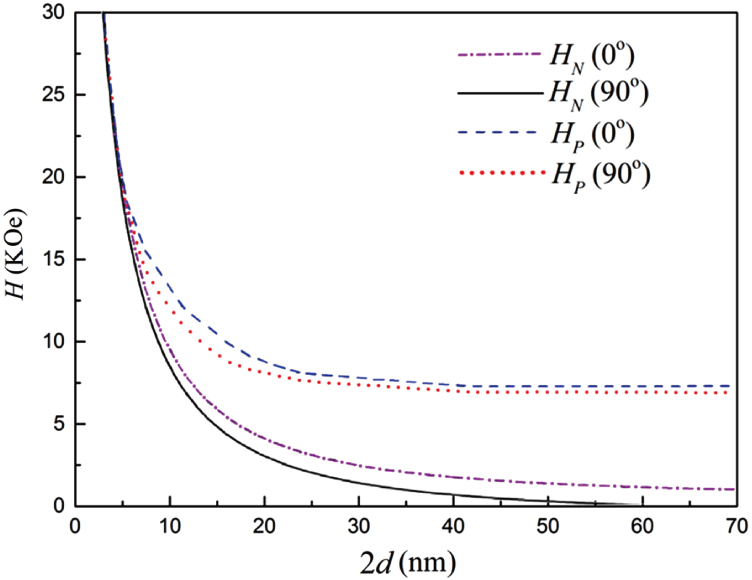 | Fig. 4. Comparison of nucleation and pinning fields for a planar α-Fe like soft defect sandwiched in Nd2Fe14B with easy axes perpendicular and parallel to the defect plane. |
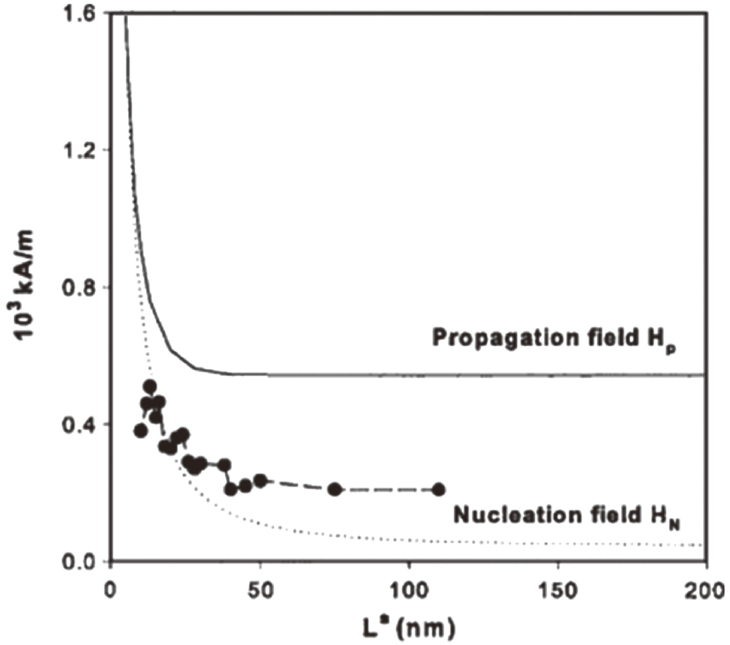 | Fig. 5. Comparison of the calculated nucleation (dashed) and propagation fields (solid) for NdFeB/Fe multilayers with the experimental data. The solid circles denote the experimental coercivity obtained for the NdFeB/Fe/NdFeB trilayer system.[26] |
Such a pinning has the attributes of both traditional nucleation and pinning. On the one hand, by considering a “−” in Eq. (
On the other hand, the pinning field given by Eq. (
 |



Kronmüller et al. obtained a similar formula as Eq. (
The self-pinning field provided by Eq. (
 |
Kronmüller et al. have made an extensive effort in revealing the coercivity mechanisms in the permanent magnets, both theoretically and experimentally.[72–75] By careful fitting of temperature dependence of the coercivity over a wide temperature interval, they found that the experimental coercivity is a linear function of Ha, i.e., 
| Table 3.
Fitted α for various materials by Kronmüller et al., where NA means that the data are not available. . |
It is of interest that they conclude that the dominant mechanism in NdFeB and PrFeB materials is nucleation while that in SmCo is pinning based on these results.[72–75] They argued that, in the case where the domain wall pinning would dominate the demagnetization process, an increase in the coercivity has to be expected. The large difference between the magnetocrystalline energy of Nd2Fe14B/Pr2Fe14B and α-Fe would result in strong pinning centers, as the domain wall energies for the two phases are quite different.[72,75] Therefore, the pinning mechanism cannot be considered as the dominating mechanism in Nd2Fe14B/α-Fe and Pr2Fe14B/α-Fe systems.[72,75] To clarify this, we may rewrite Eq. (
 |
In short, the main coercivity mechanism in the exchange-coupled permanent magnets is interface-pinning, which has the attributes of both traditional nucleation and pinning. This nucleation-pinning duality helps in solving the long-lasting disputes on the coercivity mechanism in permanent/composite magnets, and it explains the available experimental data quite well. This coercivity mechanism, proposed in the hard/soft/hard trilayers, can be extended to almost all the composite and permanent nanomagnets as a dominant mechanism. Particularly, such a mechanism can be extended to sintered magnets where the grain size is much larger than 


The models discussed in this review suit both single-phased and two-phased permanent magnets. Particularly, the self-pinning coercivity mechanism was first proposed in two-phased magnetic materials and then extended to single-phased permanent magnets. However, the comparison with the other experiments shows that the formula of the self-pinning agrees better with the single-phased materials. For example, the coercivity determined by the formula for Nd2Fe14B/Fe is 0.7 T, which is similar to the experimental data of many single-phased Nd2Fe14B without any particular coercivity enhancement. In addition, it has been discussed by Zhao et al. that,[10,25] Fe is very likely to occur in Nd2Fe14B such that many single-phased materials are in fact a two-phased one. Although these defects occupy very small volumes, they can deteriorate the coercivity significantly. It is evident from Fig.
To decrease the amount of soft Fe, the compositions used to manufacture the sintered magnets are generally Nd-rich and B-rich, rather than the stoichiometric composition R2Fe14B. Besides soft Fe, off-stoichiometric compositions were found to have smaller grains of the phase NdFe4B4 irregularly distributed between the Nd2Fel4B grains.[1] Apart from NdFe4B4 and the fcc Nd-phase forming part of the ternary eutectic, several investigations have reported the occurrence of the Laves phase NdFe2.[1] Recent investigations demonstrate that the thin grain boundary layer could be ferromagnetic,[49,76,77] supporting the theory of the self-pinning where the soft ferromagnetic phase is adopted in the model.
Experimental confirmation of this hypothesis in melt-spun ribbons was also provided.[78–82] Particularly, it is found that the optimally quenched ribbons are two-phase materials. The grains of Nd2Fe14B (approximately 30 nm in size) are surrounded by a thin film of an amorphous phase, which is rich in Nd and deficient in B with an approximate Nd:Fe ratio of 7:3.
Therefore, many single-phased permanent magnets are at least a two-phased one from a micromagnetic point of view. By contrast, an artificially fabricated two-phased magnetic material is actually composed of multi-phases as each of the two phases are not really single-phase from a micromagnetic view. Consequently, the calculated coercivity based on a two-phase model is usually larger than the experimental data.
Moreover, any poly crystals possess at least two-phases: one is the main phase and the other is the grain boundary. The grain boundary is usually a nucleation center as its local crystalline anisotropy is much lower than the main phase. Experimentally, an enhancement of the grain boundary may increase the coercivity of sintered Nd2Fe14B efficiently. This includes the addition of a heavy rare-earth element such as dysprosium and a non-magnetic element such as Cu.
Further, from a general point of view, a perfect single crystal without any structural defects may be a magnetically “two-phased” material unless it is a sphere or an ellipsoid. Reverse domains are usually nucleated at the corners and surfaces, forming a different magnetic phase in contrast to those in the center.
The interface pinning model discussed in Section
Most experiments infer that the dominant mechanism in the SmCo-type material is pinning,[73,83] while a few other experimental evidences indicate that the nucleation is also important in the magnetic reversal process. Therefore, self-pinning is considered as a governing reversal mechanism in SmCo material.
By contrast, most experimental observations made on the Nd–Fe–B-type materials indicate that the coercivity in the corresponding nanomagnets is nucleation-controlled[72,75] rather than pinning controlled, mainly because of the three reasons listed below.
(i) High low-field magnetic permeability values indicate that the domain walls can move easily, which is confirmed by the observations, suggesting there are a few pinning centers. This statement holds good for both sintered and melt-spun magnets. For sintered magnets, the grains are multi-domain at the thermally demagnetization state so that the domain walls can move freely within the grains. For melt-spun magnets, it is the easy motion of the multi-grain domain wall through the grain boundary that enhances the low-field susceptibility.
(ii) The coercivity of Nd–Fe–B and Pr–Fe–B magnetic materials is generally found to increase with the increasing magnetizing field.[84–88] As the applied field rises, the magnetic reversal becomes more difficult because of the constant removal of the residual reverse domains. These residual reverse domains behave as the nucleation centers, which facilitate the magnetization reversal and reduce the coercivity.
(iii) Most importantly, the measured coercivity is found to increase linearly with the anisotropy field Ha in a quite large temperature region.
However, these three reasons also support the self-pinning mechanism. The high low-field magnetic permeability does not exclude the self-pinning mechanism from the demagnetization process, as the self-pinning is likely to occur at the grain boundaries and defects rather than the traditional pinning centers. Recently, Li et al. found that the mechanisms of the demagnetization and initial magnetization are different for nanocomposite permanent magnets, justifying the self-pinning mechanism.[89,90] In addition, a small amount of defects can provide efficient self-pinning according to the discussions in Section 
Furthermore, many experimental observations made by the means of electron microscopy confirm that the domain-wall pinning at the grain boundaries is the reason for the high coercivity in the optimally quenched ribbons or in the over quenched and annealed ribbons. The same conclusion was drawn by Hilscher et al.[91] based on the minor loop behavior of these materials and by Pinkerton[1] based on the studies of the initial magnetization. In addition, the domain-wall pinning at the grain boundaries was reported for a variety of melt-spun materials of different anisotropy by Hadjipanayis et al.[92] using Lorentz microscopy. Recently, Zhang et al. found that the magnetic properties of the nanocomposites can be enhanced greatly by interface pinning and grain boundary pinning, suggesting a similar mechanism for the single-phased and composite permanent nanomagnets.[93–95]
Another important issue in permanent magnets is the size effect and the related grain boundary enhancement of the coercivity. The grain diameter DG in melt-spun Nd–Fe–B is usually smaller than the single-domain particle diameter D0. However, DG exceeds D0 in sintered Nd–Fe–B magnets. For this reason, many scientists concluded that the coercivity mechanism in melt-spun magnets is different from that in sintered magnets, along with the corresponding microstructures. However, it has been argued that every grain is a single-domain in the saturation state. Therefore, the difference in the coercivity mechanism of melt-spun and sintered magnets is not directly related to the single-domain size.
Several investigators found that the magnetic properties of melt-spun ribbons of a given composition depend on the quench rate, i.e., on the wheel velocity V.[96–101] When plotted as a function of the wheel velocity V, the coercive force passes through a maximum at an optimum quenching rate (V0).
Thus, Croat et al. proposed that the peak coercivity corresponds to a grain size equal to the single-domain particle size. In under quenched ribbons (

According to the self-pinning theory, the grain-size-dependent coercivity in sintered magnets is possibly due to the difference in the defect size. Larger the defect size, smaller the coercivity is.
The peak grain size is approximately 30 nm for melt-spun Nd2Fe14B, which is approximately one order smaller than that of the theoretical single domain grain size D0. The coercivity decreases for smaller grain size, which is well explained by the hybrid model proposed by Zhao et al.[18,19,102–104] The energy barrier for the motion of the transition region between the neighboring grains with different easy axes can be tunneled by the thermal activation within the hybrid model, when the grain size is smaller (approximately 10 nm for Nd–Fe–B). Therefore, the coercivity can be improved by the grain boundary pinning, which prevents the motion of the transition region.
There is a general agreement that the grain boundary pinning is important to obtain a high coercivity in both melt-spun and sintered Nd–Fe–B, which is consistent with the theory of self-pinning.
In summary, the study of the magnetic reversal, as well as the related coercivity mechanism has extensive technological applications in many nanostructured fields such as permanent magnetic materials, magnetic recording, and micromechanics. The micromagnetic models and the related coercivity mechanism such as self-pinning initially proposed for a hard/soft composite can be applied well to the so-called single-phased permanent magnets where defects are difficult to be excluded.
The underlying mechanism of the coercivity has been a topic of interest for many years in permanent magnets. It is motivated by the fact that the measured coercivity approaches only 20%–40% of the theoretical nucleation fields derived from the micromagnetic theory as developed by Brown and Stoner–Wohlfarth. Crystal defects are probably responsible for the lower measured coercivity. Therefore, two main approaches have been proposed to resolve this discrepancy. One is a micromagnetic approach while the other is a phenomenological “global” approach. Both methods can resolve the discrepancy by choosing the adequate parameters. However, their underlying philosophies are different. The micromagnetic approach can differentiate the reversal mechanisms, whereas the global approach cannot. Thermal activation effects are intrinsically considered in the “global” model, whereas they are neglected in the micromagnetic approach.
The simple SW model can give an explicit formula and a clear underlying coercivity mechanism based on the coherent rotation of the isolated grains. Such a model is exceedingly simple sometimes. However, it is widely used among experimentalists. By contrast, the key issue of the numerical investigations is to determine an accurate mimic of the domain wall, which can solve the problems with inherent geometric and physical complexity in principle. This approach, however, is sometimes exceedingly complicated, as it requires a large amount of meshes because of the thin domain wall of the permanent magnets.
In this review, the recently proposed self-pinning mechanism has been reviewed in detail, which can be applied to well-oriented permanent nanomagnets and sintered magnets. The self-pinning coercivity mechanism has the attributes of both nucleation and pinning, where a simple formula similar to the nucleation model can be derived. The pinning field arises from the magnetic property difference between the nucleation center and the main phase. Such a pinning is inherently linked to a nucleation center, which can explain the experiments supporting either the nucleation or traditional pinning.
| [1] | |
| [2] | |
| [3] | |
| [4] | |
| [5] | |
| [6] | |
| [7] | |
| [8] | |
| [9] | |
| [10] | |
| [11] | |
| [12] | |
| [13] | |
| [14] | |
| [15] | |
| [16] | |
| [17] | |
| [18] | |
| [19] | |
| [20] | |
| [21] | |
| [22] | |
| [23] | |
| [24] | |
| [25] | |
| [26] | |
| [27] | |
| [28] | |
| [29] | |
| [30] | |
| [31] | |
| [32] | |
| [33] | |
| [34] | |
| [35] | |
| [36] | |
| [37] | |
| [38] | |
| [39] | |
| [40] | |
| [41] | |
| [42] | |
| [43] | |
| [44] | |
| [45] | |
| [46] | |
| [47] | |
| [48] | |
| [49] | |
| [50] | |
| [51] | |
| [52] | |
| [53] | |
| [54] | |
| [55] | |
| [56] | |
| [57] | |
| [58] | |
| [59] | |
| [60] | |
| [61] | |
| [62] | |
| [63] | |
| [64] | |
| [65] | |
| [66] | |
| [67] | |
| [68] | |
| [69] | |
| [70] | |
| [71] | |
| [72] | |
| [73] | |
| [74] | |
| [75] | |
| [76] | |
| [77] | |
| [78] | |
| [79] | |
| [80] | |
| [81] | |
| [82] | |
| [83] | |
| [84] | |
| [85] | |
| [86] | |
| [87] | |
| [88] | |
| [89] | |
| [90] | |
| [91] | |
| [92] | |
| [93] | |
| [94] | |
| [95] | |
| [96] | |
| [97] | |
| [98] | |
| [99] | |
| [100] | |
| [101] | |
| [102] | |
| [103] | |
| [104] |


